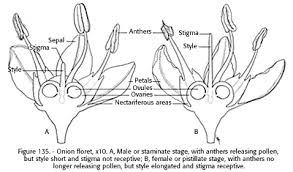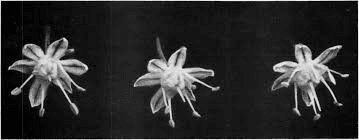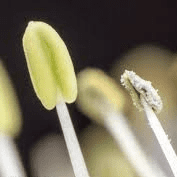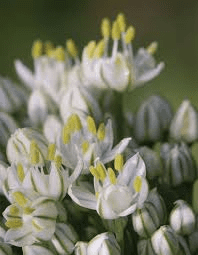Onion stigma is a part of the flower’s reproductive system, and in onions, it plays a crucial role in the plant’s life cycle.
The stigma is a part of the pistil, which is the female reproductive organ of a flower. In onions, the flower structure is relatively simple but effective for its purpose. The pistil consists of the stigma, style, and ovary. The stigma is the sticky surface at the top of the pistil where pollen grains land and adhere. This process is essential for pollination, as pollen must travel from the male part of the flower (the stamen) to the stigma for fertilization to occur.
Onions are typically biennial plants, meaning they complete their life cycle in two years. In the first year, they focus on growing bulbs, which are the edible parts of the plant. During the second year, the plant produces a flower stalk that emerges from the bulb. This flowering stalk is where the reproductive process occurs, including the role of the stigma.
The onion flower is a cluster of small, white or pinkish florets that are grouped together in a spherical head. Each floret contains a pistil with its stigma. As the flower blooms, the stigma becomes receptive to pollen, which can be transferred by wind or insects. Once pollination occurs, the fertilized ovary develops into seeds, which can then be harvested and used to grow new onion plants.
The stigma’s role in this process is vital because it ensures that pollen is effectively captured and used for fertilization. Without a functioning stigma, the chances of successful seed production would be significantly reduced. The development and health of the stigma can directly impact the overall reproductive success of the onion plant.
Interestingly, the study of the stigma in onions and other plants contributes to our understanding of plant reproduction and can help improve agricultural practices. For example, researchers might examine how different environmental conditions affect the stigma’s receptivity or how it interacts with pollen. This knowledge can lead to better crop yields and more efficient farming techniques.
In summary, the stigma of onions is an integral part of their reproductive system. It plays a crucial role in capturing pollen for fertilization, which is essential for producing seeds and ensuring the continuation of the plant species. Understanding the stigma’s function helps us appreciate the complexity of plant reproduction and its significance in agriculture.
The Economic Importance and Uses of Onion Stigma

1. Culinary Use: Onion stigma, while not commonly used, can add a unique flavor and aroma to dishes in niche culinary practices.
2. Medicinal Use: In traditional medicine, onion stigma is believed to have properties that can help in treating respiratory issues and digestive problems.
3. Nutritional Supplements: Onion stigma contains nutrients that are sometimes utilized in dietary supplements for their potential health benefits.
4. Natural Pesticide: Onion stigma can be used to create natural pesticides, leveraging its properties to help control pests in agriculture.
5. Skincare Products: Extracts from onion stigma are used in some skincare products for their potential anti-inflammatory and antioxidant effects.
6. Fertilizer: Onion plant residues, including stigma, can be composted to produce nutrient-rich fertilizer for crops.
7. Biofuel Production: Research is exploring the use of onion stigma and other plant residues in biofuel production as a sustainable energy source.
8. Traditional Medicine: Onion stigma is used in traditional medicine practices to treat ailments such as coughs and colds.
9. Antimicrobial Agents: Onion stigma can be used in natural antimicrobial products to help preserve foods and improve hygiene.
10. Natural Dyes: Onion stigma can be used to produce natural dyes for textiles and other materials.
11. Agricultural Use: Onion stigma, as part of the plant, can be used to improve soil health and structure when used as green manure.
12. Flavoring Agent: Although less common, onion stigma can be used in certain specialty foods for its unique flavor profile.
13. Preservative: Onion stigma has preservative properties that can be applied in preserving certain foods.
14. Cosmetic Use: Onion stigma extracts are sometimes included in cosmetics for their potential to improve skin health and appearance.
15. Research and Development: Onion stigma is being studied for its potential applications in biotechnology and pharmaceuticals.
16. Traditional Remedies: Used in various traditional remedies, onion stigma is believed to aid in improving digestion and respiratory health.
17. Health Products: Onion stigma is used in some health products for its antioxidant and anti-inflammatory properties.
18. Economic Crop: Onion plants, including stigma, contribute to the agricultural economy by offering additional uses and value-added products.
Read Also: 24 Medicinal Health Benefits Of Atriplex argentea (Silverscale Saltbush)
The Products and By-products That Can Be Derived From Onion Stigma

1. Onion Stigma Extract: Used in supplements and skincare products for its potential health benefits.
2. Onion Stigma Powder: Made by drying and grinding onion stigma, used in niche culinary and medicinal applications.
3. Onion Stigma Oil: Extracted oil used in cosmetics and traditional medicine.
4. Onion Stigma Tea: Brewed from dried onion stigma, used for its potential health benefits.
5. Onion Stigma Paste: Blended form used in medicinal and culinary applications.
6. Onion Stigma Fertilizer: Composted stigma used to enrich soil and improve crop yields.
7. Onion Stigma Compost: Organic compost made from onion stigma and other plant residues.
8. Onion Stigma Biofuel: Biofuel produced from onion stigma and other plant materials.
9. Onion Stigma Dye: Natural dye made from onion stigma, used in textiles and arts.
10. Onion Stigma Pesticide: Natural pesticide made from onion stigma to control pests in agriculture.
11. Onion Stigma Skincare Cream: Creams containing onion stigma extracts for skin health benefits.
12. Onion Stigma Soap: Soap made with onion stigma extracts for its potential skin benefits.
13. Onion Stigma Capsules: Capsules containing powdered onion stigma used as a dietary supplement.
14. Onion Stigma Tincture: Alcoholic extract used in traditional medicine for various ailments.
15. Onion Stigma Flakes: Dehydrated and flaked onion stigma used in specialty foods.
16. Onion Stigma Infusion: Infused oils and liquids for culinary and medicinal purposes.
17. Onion Stigma Enzyme: Enzyme preparations derived from onion stigma for use in biotechnological applications.
Read Also: 24 Medicinal Health Benefits Of Atriplex argentea (Silverscale Saltbush)
Frequently Asked Questions (FAQs) About Onion Stigma

1. What are the health benefits of onion stigma? Onion stigma is believed to have antioxidant and anti-inflammatory properties that may support respiratory and digestive health.
2. How can I use onion stigma in cooking? Onion stigma can be used in specialty culinary applications, although it is less common compared to other parts of the onion.
3. Are onion stigma products safe for pets? Onion stigma products should be used with caution around pets, as onions in general can be harmful to animals.
4. How should I store onion stigma? Onion stigma should be stored in a cool, dry place to maintain its quality and effectiveness.
5. Can onion stigma help with skin conditions? Onion stigma is used in some skincare products for its potential to reduce inflammation and improve skin health.
6. What are the different types of onion plants? Common types of onion plants include yellow onions, red onions, and green onions, each with distinct uses and flavors.
7. How do I prepare onion stigma for use? Onion stigma can be dried and ground or used fresh, depending on the intended application.
8. Can onion stigma be used as a natural pesticide? Yes, onion stigma can be used to create natural pesticides to help control garden pests.
9. What is the nutritional value of onion stigma? Onion stigma contains some nutrients and compounds that may offer health benefits, but it is not as nutrient-rich as other parts of the onion.
10. How is onion stigma used in traditional medicine? In traditional medicine, onion stigma is used to treat respiratory issues, digestive problems, and other health conditions.
Read Also: Everything You Need to Know About Grimal Jewelry Financing






